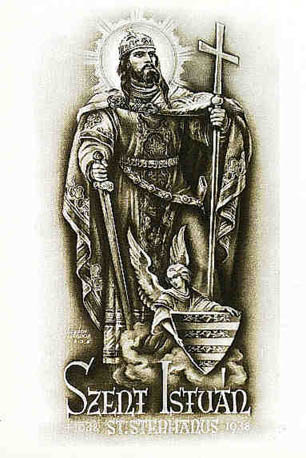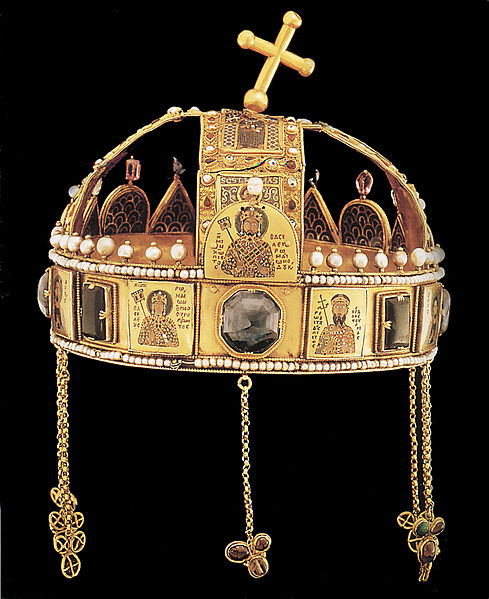Zeal to propagate and strengthen the faith
Let us consider another text.
“The post-comunio from St. Stephen’s Mass says that the king’s zeal to ‘spread and strengthen the faith in the country earned him the heavenly kingship.’ He established Our Lady as Patroness of Hungary. And he died in 1038 on the day of the ‘Great Lady,’ a designation Hungarians give Our Lady by virtue of an edict of the holy king.”
These biographical details are fine, accurate and interesting because they show well some aspects of the king normally left out of such biographies. That is, they present him as the founder of Christian civilization in Hungary; as “converter” of his people; as a warrior who had to face the adversaries of the Faith with sword in hand; as the founder of one of the most beautiful institutions, the apostolic monarchy of Hungary, which we will address below. All that is alluded to in an indirect and veiled fashion.
This expression from the post-comunio is thus perfectly legitimate: “His zeal to spread and strengthen the faith in the country earned him the heavenly kingship.”
All this is very well, but numerous saints can be said to have had zeal in “propagating and strengthening the faith.” Some did it as speakers, others as missionaries, still others by dedicating themselves to charitable works, etc.
However, St. Stephen had this zeal in a special way and it would be very interesting to point it out here because if left as is I think it loses some color. And therefore it is up to us to emphasize this point.
St. Stephen was a king, a saint chosen by Divine Providence to lead his people to the fold of the Church. Thus, as the king and natural lord of his people he was chosen by God to take them to Our Lord Jesus Christ.
This is a work proper to a natural lord, to the temporal authority that must support the Church’s effort to bring souls to God. And he excelled in accomplishing this task as temporal lord and governor because he led his entire nation to God.
The Apostolic Monarchy in Hungary
This type of kings that convert and found civilizations is something very special in hagiography. And for us [TFP members] they represent a lot because, since we consecrate ourselves to the temporal order and to a proper constitution of the temporal order, it is easy to understand that a saint who gave us an example in that order is very important to us and should be the special object of our devotion.
I would like to dwell a little more about the apostolic monarchy in Hungary.
We have seen how St. Stephen received the title “Apostolic King” because of his great apostolate and for using royalty to convert his people; after him, all the kings of Hungary, until the last, took the same title.
The existence of an “apostolic royalty” is a beautiful fact that should be underlined. Since the Hungarian duchy pre-dated its conversion, the conversion of Hungarians operated as it were a re-foundation of the Hungarian people. One can also say that they founded themselves once again. And that, as it were, they were born to a new life in the very act of conversion as the duchy became a monarchy.
Because of this act of apostolate, the king of that monarchy became the “Apostolic King.” And he is “Apostolic King” because of his mission to continue expanding the Church in those lands, defending against the Turks, and rendering service to the Catholic Faith in all circumstances and needs of the Church in those lands.
This mission – to be accomplished by a king – and the character that it gives Hungary—conferred a special vocation on the reigning dynasty. And with this special vocation, a kind of special grace. And with this special grace, a kind of alliance between God and the family that continued that mission. That alliance with the family to fulfill this mission would last for as long as its infidelities were not such that God would do to it what He did with Saul: abandoning him and choosing another. Because infidelity can clearly reach that point.
St. Stephen’s Crown: for the People, a Relic
But as long as that point of infidelity is not attained, something sacred remains in the institution of the Hungarian monarchy which is a charisma, like a supernatural grace that surrounds it and fills people with respect for it. And the strength of this charisma is very visible in the fidelity of Hungarians to royalty. We can see it very well by the prestige of the crown worn by St. Stephen, that historic crown respected by the Hungarians as a true relic.
That crown did not fall into communist hands. When the communist regime took over Hungary, pious hands took St. Stephen’s crown so it would not to fall into their hands. It seems that it is kept in a bank. They say that Cardinal Mindszenty knows where it is. I do not know anyone else who knows where it is.[i]
The communists want the crown because Hungarians respect it so much that to them its possession is almost equivalent to the very holding of power. The communists are always terrified at the idea that someone may appear there hoisting St. Stephen’s crown. For if someone entered Hungary taking that crown, flying St. Stephen’s crown [like a banner]… they fear that after so many years of communist rule the people may rise up, as it is the crown of the holy king.
Why does the crown have all this prestige? Why does it command all this respect? There is something charismatic surrounding the crown and the dynasty that continues and which is precisely the fruit of that alliance. As we said, it is a kind of infusion of graces into the institution related to the king’s family which determines the sacred longevity of a certain order of things.
The Fidelity of Hungarians to the House of Austria
In my boyhood I have always heard that Hungary was enslaved by Austria. And that the emperors of the house of Austria despised and humiliated Hungary. And therefore, that all that Hungary wanted was to break free from the house of Austria.
To my great surprise – I was a child – I heard the news that Austria was doing nothing for the restoration of the Habsburgs but that Hungary had risen to restore the Emperor of Austria! Hungary, an independent country, rose to restore the emperor of Austria that everyone claimed she hated.
And, indeed, were it not for the weakness of Emperor Charles, Hungary would have quickly have become once again a Habsburg monarchy.[ii] Why? Because of the profound fidelity inherent to this alliance with the apostolic monarchy, the apostolic kingdom, and the apostolic people.
To Be Continued….
[i] Here Prof. Plinio narrates what was known about the holy crown at the time. We do not know how it left Hungary. Some claim that at the end of World War II the crown and Hungary’s regalia were recovered in Mattsee, Austria, on May 4, 1945 by the U.S. 86th Infantry Division and taken to the United States. Others say that on May 2, 1945, an Hungarian colonel delivered the crown and other jewels of the Hungarian monarchy to an American colonel. Be it as it may, this treasure was taken to the United States and kept at the United States Gold Reserve in Fort Knox, Kentucky, until the highly controversial action by President Jimmy Carter, who returned it all to the Hungarian Communist government on January 6, 1978 causing heated polemics. After the fall of communism, in 1990, the crown was incorporated into the coat of arms of the Hungarian Nation. (Cf. http://hungary.usembassy.gov/holy_crown.html; http://en.wikipedia.org/wiki/Holy_Crown_of_Hungary.
[ii] “Encouraged by Hungarian royalists (“legitimists”) in 1921 Charles twice tried to claim the throne of Hungary but failed, mostly because of the Hungarian regent, Miklós Horthy (the last admiral of the Austrian-Hungarian Navy) who refused to support him.” (http://en.wikipedia.org/wiki/Charles_I_of_Austria.)












